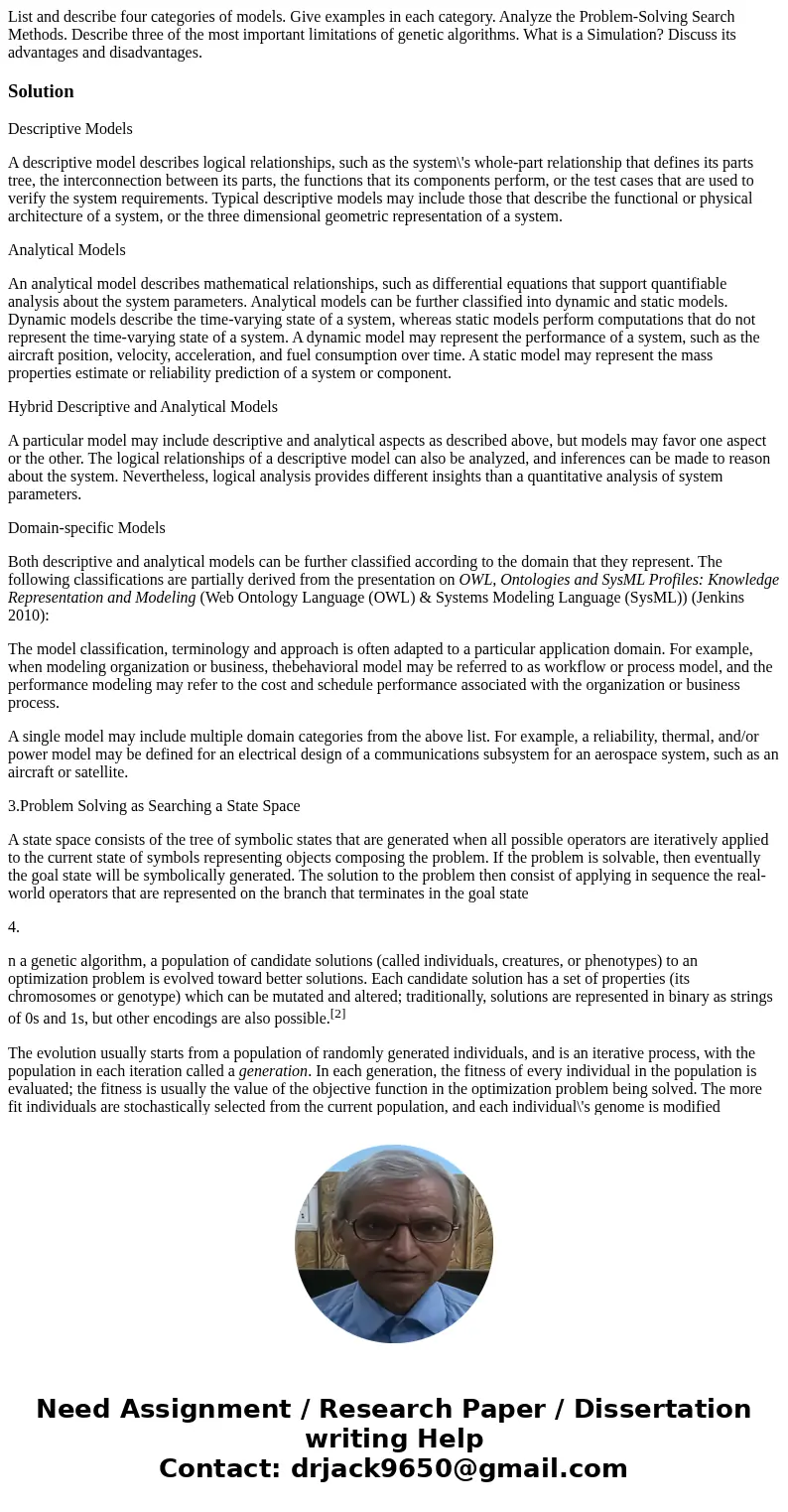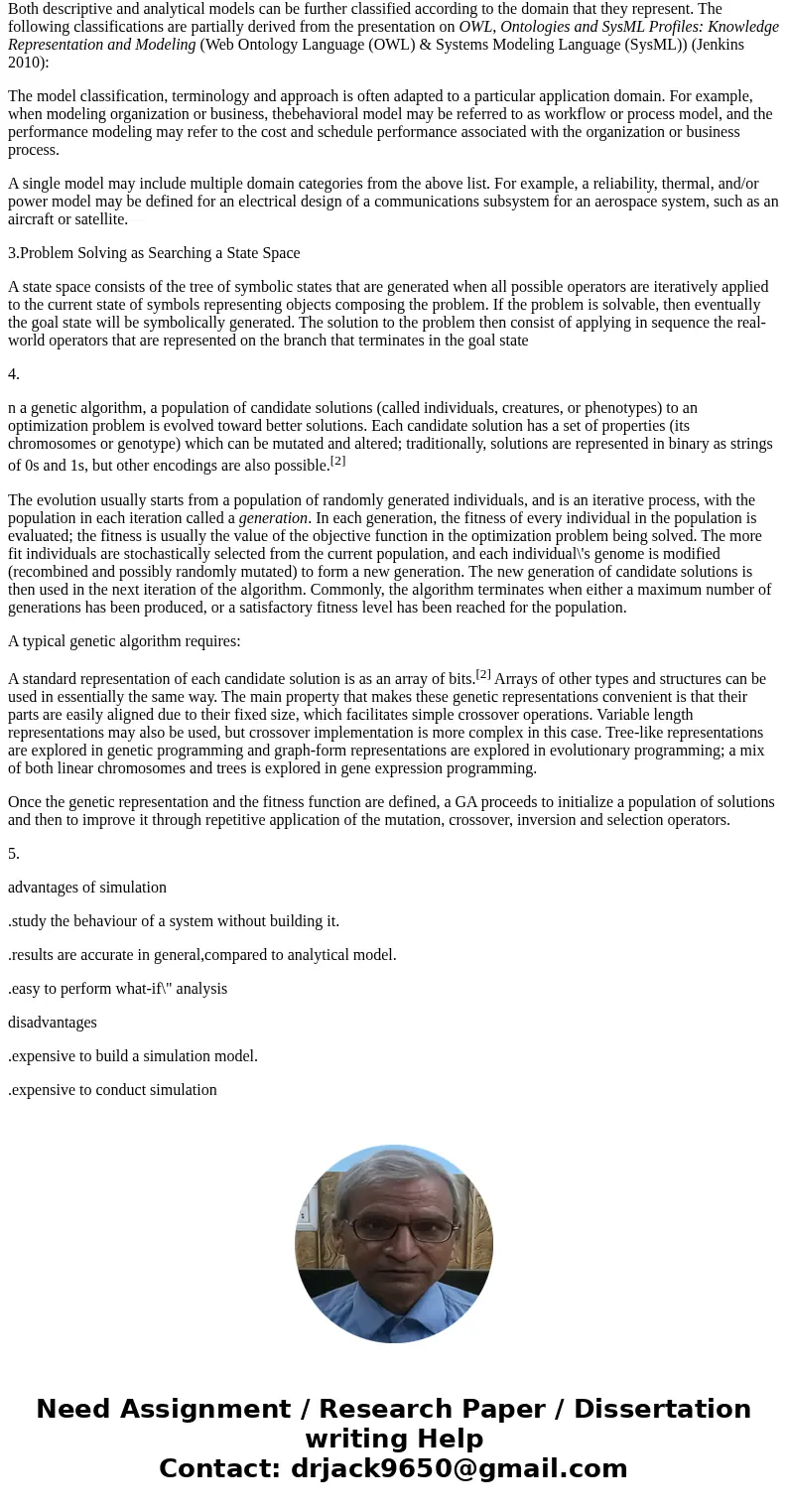List and describe four categories of models Give examples in
Solution
Descriptive Models
A descriptive model describes logical relationships, such as the system\'s whole-part relationship that defines its parts tree, the interconnection between its parts, the functions that its components perform, or the test cases that are used to verify the system requirements. Typical descriptive models may include those that describe the functional or physical architecture of a system, or the three dimensional geometric representation of a system.
Analytical Models
An analytical model describes mathematical relationships, such as differential equations that support quantifiable analysis about the system parameters. Analytical models can be further classified into dynamic and static models. Dynamic models describe the time-varying state of a system, whereas static models perform computations that do not represent the time-varying state of a system. A dynamic model may represent the performance of a system, such as the aircraft position, velocity, acceleration, and fuel consumption over time. A static model may represent the mass properties estimate or reliability prediction of a system or component.
Hybrid Descriptive and Analytical Models
A particular model may include descriptive and analytical aspects as described above, but models may favor one aspect or the other. The logical relationships of a descriptive model can also be analyzed, and inferences can be made to reason about the system. Nevertheless, logical analysis provides different insights than a quantitative analysis of system parameters.
Domain-specific Models
Both descriptive and analytical models can be further classified according to the domain that they represent. The following classifications are partially derived from the presentation on OWL, Ontologies and SysML Profiles: Knowledge Representation and Modeling (Web Ontology Language (OWL) & Systems Modeling Language (SysML)) (Jenkins 2010):
The model classification, terminology and approach is often adapted to a particular application domain. For example, when modeling organization or business, thebehavioral model may be referred to as workflow or process model, and the performance modeling may refer to the cost and schedule performance associated with the organization or business process.
A single model may include multiple domain categories from the above list. For example, a reliability, thermal, and/or power model may be defined for an electrical design of a communications subsystem for an aerospace system, such as an aircraft or satellite.
3.Problem Solving as Searching a State Space
A state space consists of the tree of symbolic states that are generated when all possible operators are iteratively applied to the current state of symbols representing objects composing the problem. If the problem is solvable, then eventually the goal state will be symbolically generated. The solution to the problem then consist of applying in sequence the real-world operators that are represented on the branch that terminates in the goal state
4.
n a genetic algorithm, a population of candidate solutions (called individuals, creatures, or phenotypes) to an optimization problem is evolved toward better solutions. Each candidate solution has a set of properties (its chromosomes or genotype) which can be mutated and altered; traditionally, solutions are represented in binary as strings of 0s and 1s, but other encodings are also possible.[2]
The evolution usually starts from a population of randomly generated individuals, and is an iterative process, with the population in each iteration called a generation. In each generation, the fitness of every individual in the population is evaluated; the fitness is usually the value of the objective function in the optimization problem being solved. The more fit individuals are stochastically selected from the current population, and each individual\'s genome is modified (recombined and possibly randomly mutated) to form a new generation. The new generation of candidate solutions is then used in the next iteration of the algorithm. Commonly, the algorithm terminates when either a maximum number of generations has been produced, or a satisfactory fitness level has been reached for the population.
A typical genetic algorithm requires:
A standard representation of each candidate solution is as an array of bits.[2] Arrays of other types and structures can be used in essentially the same way. The main property that makes these genetic representations convenient is that their parts are easily aligned due to their fixed size, which facilitates simple crossover operations. Variable length representations may also be used, but crossover implementation is more complex in this case. Tree-like representations are explored in genetic programming and graph-form representations are explored in evolutionary programming; a mix of both linear chromosomes and trees is explored in gene expression programming.
Once the genetic representation and the fitness function are defined, a GA proceeds to initialize a population of solutions and then to improve it through repetitive application of the mutation, crossover, inversion and selection operators.
5.
advantages of simulation
.study the behaviour of a system without building it.
.results are accurate in general,compared to analytical model.
.easy to perform what-if\" analysis
disadvantages
.expensive to build a simulation model.
.expensive to conduct simulation


 Homework Sourse
Homework Sourse